Introduction
Grace, elegance, purity and sophistication feature highly in Japanese culture. They are also synonymous with the Miyabi brand by Zwilling J.A. Henckels.
Miyabi Knives exemplify the traditions and craftsmanship of Japanese sword makers & skilled artisans who once produced the finest Japanese swords. Miyabi merges the treasured traits of samurai swords – exceptional & beautiful sharpness, tradition, craftsmanship, and performance – with contemporary design for the ultimate kitchen knives. They’re forged from premium steels and modern state-of-the-art technology with the excellence of German engineering. The fact that it takes more than 100 steps and 42 days to make one single knife is a true testament to the sheer quality, workmanship & stringent benchmark standards Miyabi set themselves.
Miyabi knives are authentically designed by the Japanese and embody a contemporary Japanese design. Miyabi does not need to try to imitate the style of Japanese knives, they really are authentic Japanese knives. Each knife is hand-finished in the honbazuke style (read more below) with a true cutting edge in the Zwilling J.A.Henckels factory in Seki, Japan. The authentic Japanese blade design and extraordinary sharpness of Miyabi artisan knives are sure to captivate you from the first encounter. Japanese cuisine connoisseurs are impressed time and time again by the balanced weight distribution of the knives and their comfortable handle.
The Japanese recognised long ago how important sharp knives are for retaining the taste and texture of delicate dishes like sashimi. With the growing popularity of Japanese cuisine, more and more people are appreciating the unique aesthetic of ingredients cut with precision and grace. This is exactly what Miyabi knives offer. They’re developed to give professional chefs and home cooks the enjoyment of precise preparation with exceptionally sharp knives.
Manufactured in Seki Japan
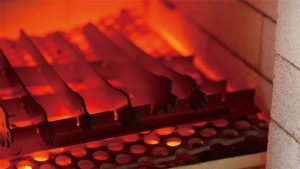
Since the 14th Century, Seki has been the capital of the Japanese sword and knife manufacturing industry. World-renowned for their artistry, the Miyabi knife production in Seki combines German engineering with the finest Japanese craftsmanship, hence why Seki is often referred to as the Japanese Solingen. ZWILLING J.A. HENCKELS acquired one of the leading Seki-based manufacturers of high-quality knives in 2004. The result of this collaboration is the world-class Japanese knives of Miyabi.
Honbazuke Honing
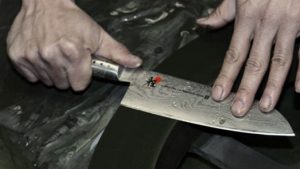
This traditional Japanese honing technique gives every Miyabi blade its incomparable sharpness. Honbazuke honing originates from traditional Japanese knife production. Each blade is sharpened and polished by hand in three stages in a very complex process. The blade is first coarsely ground using a vertically rotating sharpening stone, followed by a fine honing using a horizontally rotating sharpening stone. Lastly, the edge is then polished using a leather stropping block for scalpel-like sharpness. The result of the v-edge honing is a 19° symmetrical blade.
Japanese knives differ from European knives by the shape and material of the blade. The extremely sharp blade profile allows the precise, fine and smooth cutting action, typical in the preparation of Japanese cuisine.
Premium Steel
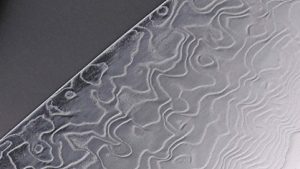
As well as the blade profile and honing, the type of steel helps to determine the sharpness of a knife and how long it remains sharp.
The blade core of the Miyabi Birchwood 5000MCD Series is made of MicroCarbide MC63 powder steel and is surrounded by 100 layers of two different types of steel with different levels of hardness. MicroCarbide MC63 powder steel is a high-grade steel for the highest demands. It is commonly used by experienced users of Japanese knives. As with all knives, this blade type needs to be handled with extreme caution, but as a result of your caution, you are rewarded with the ultimate feeling of sharpness. The Miyabi Kaizen II 5000FCD Series’ blades are formed by 49 layers of steel with a Rockwell hardness of approximately 61. The blade features an FC61 fine carbide steel blade core and is finished with a unique damask pattern.
CRYODUR VS FRIODUR
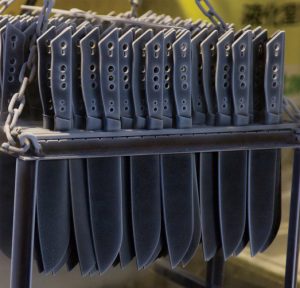
The full potential of the knife steel is revealed through a special thermal treatment. This determines the knife’s hardness, sharpness, durability and corrosion resistance. The combination of the very best thermal treatment and excellent steel guarantees ideal knife properties. Miyabi 5000MCD Birchwood Knives are finished with a CRYODUR process while the Miyabi 5000FCD Kaizen II Series is finished with a FRIODUR process. I suppose you’d like to actually know what that means though?
CRYODUR
First, the steel is heated. The blade is then quenched momentarily to room temperature and finally is frozen and hardened at -196°C. This process improves corrosion resistance. The blade regains its flexibility by being reheated (a.k.a tempering)
FRIODUR
First, the steel is heated. The blade is then cooled to achieve optimum hardness and elasticity. During ice-hardening, the blade is frozen to -70°C. This process improves corrosion resistance. The final tempering of the blade improves its flexibility, ensuring it can be used safely and preventing it from fracturing
Translated roughly, cryo means icy cold and frio means chilly. Hence the two levels of temperatures in their processes. ‘dur’ translates into hard. Cryodur (Icy-cold Hard) and Friodur (Chilly Hard)
Miyabi 5000MCD Birchwood Series
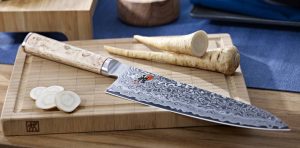
The Miyabi 5000MCD Birchwood Series is a collection of uniquely designed precision knives that perfectly combine function and ergonomics. Aesthetics have played a key role in Japanese cuisine since time immemorial. The look of a dish and the way it is presented on the plate are just as much a part of the pleasure as its taste and aroma. In the kitchen, Japanese chefs are just as demanding where aesthetics are concerned as they are with functionality. The Miyabi 5000MCD series of knives provides professionals and ambitious amateur chefs an absolute world-class and gorgeous collection.
Key Features:
- MicroCarbide Powder Steel
- CRYODUR ice-hardened to 63 Rockwell Hardness – undergoes a four-step hardening process which maximises the properties of the steel
- Traditional 3-step Honbazuke hand-honed edge – Symmetrical Blade Profile
- The core of the SG2 super steel is protected by a 101-layer stunning flower Damascus pattern
- Stunning Masur Birch handle features a striking mosaic pin, red spaces accents, and a steel end cap
- D-shaped handle for perfect balance, optimum control, and tireless cutting
Birch Handle
Each handle made of top-quality Masur birch is also unique. The structure of the wood handle is reflected through the interplay of lines and stripes. The warmth of the natural wood contrasts nicely with the steel blade. A mosaic pin finishes off the sophisticated look.
Premium Steel
The blade core made of MicroCarbide MC63 powder steel is surrounded by 100 layers of two different types of steel with different levels of hardness. MicroCarbide MC63 powder steel is a high-grade steel for the highest demands.
Extremely Hard Blade
The CRYODUR blade is hardened using a specially developed ice-hardening process at -196°C that guarantees an extreme hardness of 63 Rockwell and a lasting sharp blade.
D-Shaped Handle
The traditional Japanese ‘D-shaped’ handle ensures all handle styles are ergonomic and enables you to work without tiring. The ‘D-shaped’ handle is rounded off at its end with a decorative end cap with a logo.
Sleek Damask Design
A special blade treatment alters the surface structure of each layer, giving each blade its individual floral damask pattern.
Miyabi 5000FCD Kaizen II Series
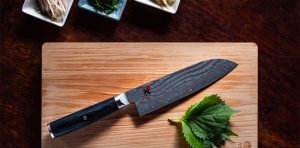
The Kaizen II collection boasts traditional Japanese craftsmanship combined with the best hardening technology and beautiful modern design. The Miyabi 5000FCD Series will delight lovers of Japanese cuisine with its perfect balance and comfortable handle. The blade core, constructed from FC61 Fine Carbide steel holds its sharp edge and is incredibly durable, surrounded by 48 layers of Damask steel. FRIODUR ice-hardened to a 61 Rockwell hardness ensures extreme hardness, corrosion resistance and material elasticity of the knives. The sleek floral damask pattern on the blade is a result of the special blade treatment which alters the surface structure of each layer, giving each blade its individual floral damask pattern. A traditional Japanese Honbazuke (a three-stage grinding, sharpening and polishing process) v-edge honing gives the 19° symmetrical blade incomparable sharpness (not single bevel) so it’s suitable for both right and left-handed use. There is no finger guard so the whole length of the cutting edge can be used. The ergonomic black Pakka Wood handle seamlessly joins the half-bolster and is comfortable to hold, balanced with a steel end cap and decorative pin, completing the sophisticated design. The smooth join helps to prevent calluses from forming on the thumb and forefinger.
Key Features:
- FC61 fine carbide steel blade core
- 48 layers of steel surrounding the core create the Damascus-design
- FRIODUR ice-hardened for extreme hardness
- Rockwell hardness of approximately 61
- Symmetrical cutting edge
- Pakka wood handle
- Steel mosaic pin and handle end cap
Which Miyabi Knife Do I Use?
There are many different shapes of blade, and each blade shape has its specific properties when preparing food. To achieve the best results, always choose the right knife.
KUDAMONO
The Kudamono is a vegetable knife and is perfect for cutting and peeling fruit and vegetables. Symmetrical blade. Blade length: 90mm
SHOTOH
The Shotoh is a small knife, ideal for cutting, peeling and garnishing fruit and vegetables. After the Santoku, the Shotoh is the best selling blade shape in Japan. Symmetrical Blade. Blade length: 90-150mm
CHUTOH
The Chutoh is a medium-sized knife. It is used when the Shotoh is too small and the Gyutoh too big: an all-purpose kitchen knife. Symmetrical blade. Blade length: 160mm
GYUTOH
The Gyutoh is regarded as the slicing knife and is mainly used for finely slicing meat and large vegetables.
DEBA
The Deba is the coarse knife used in Japanese cuisine. Its robust blade is especially good for filleting and boning fish and meat. Asymmetrical blade. Blade length: 170mm
KODEBA
The Kodeba is a smaller version of the Deba and is also used for filleting and boning, as well as for chopping vegetables. Asymmetrical blade. Blade length: 100mm
SANTOKU
Santoku is the best-selling shape of blade in Japan and translates as “Three Virtues”. The name relates to the versatility of this blade shape, for instance for vegetables, meat or fish. Symmetrical blade. Blade lengths: 150-180mm
SUJIHIKI
The Sujihiki is a very fine carving knife. It is ideal for slicing raw or cooked meat and fish. Symmetrical blade. Blade length: 240-270mm
YANAGIBA
Yanagiba means “willow leaf blade”. The knife is particularly suitable for cutting raw fish fillets into thin slices (sashimi) and is often referred to as a sashimi knife. The Yanagiba can also be used to trim fillets of meat. Asymmetric blade. Blade length: 270mm
KIRITSUKE
Kiritsuke literally means “slit open”. This blade shape is an all-rounder in Japanese cuisine and is widely used for the preparation of sashimi and the fine slicing of vegetables. Asymmetrical blade. Blade length: 240mm
SAKIMARU TAKOBIKI
The Sakimaru Takobiki is perfect for preparing sushi and sashimi. The fine blade is ideal for slicing wafer-thin slices of raw fish. Asymmetrical blade. Blade length: 270mm
BREAD KNIFE/PANKIRI
The scalloped edge cuts effortlessly through hard bread crusts and slices thinly and cleanly. Serrated blade. Blade lengths: 230-240mm
Caring for your Miyabi Knife
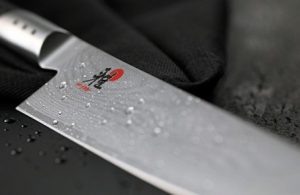
Washing
DON’T wash in the dishwasher! This may cause corrosion of the blades!
DO clean by hand. Run under lukewarm water with a mild detergent and a scratch-free cloth or sponge. Dry knives immediately. Do not leave your knives wet or dirty for any length of time to avoid discolouration or rust.
Storing
DON’T store loose in a drawer! This can cause the blade to be damaged or chip as well as potentially cutting you as you rummage through drawers.
DO store in a dry, moisture-free place to avoid rusting or discolouration. We stock a vast range of knife blocks, magnetic racks as well as knife guards & knife rolls.
How to Sharpen Miyabi Knives
With high-quality, high-precision blades, regular maintenance is key
Miyabi knives should only be sharpened with professional sharpeners due to the extremely hard steel and the fine Honbazuke honing of the knives. Take care to use the right tool as well as the correct technique.
Sharpening Miyabi Knives with a Whetstone
Follow this step-by-step guide by Miyabi to professionally use a whetstone to sharpen your Miyabi knife. Please read all instructions in full before starting to sharpen your knife.
Preparation
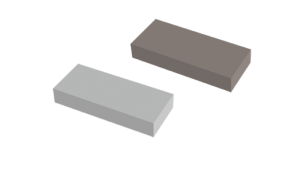
Immerse the sharpening stone in water for five minutes before using. Then place the non-slip side of the stone facing down into the wooden base. For best results, maintain the wetness of the stone throughout the entire process. A grey fluid is produced during sharpening; do not wash it off as it improves the process.
Alignment
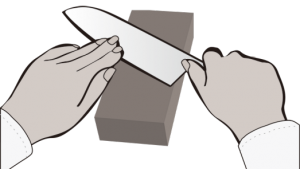
Now hold the handle of the knife firmly in one hand and, with the blade facing you, place it on the sharpening stone at an angle of 10 – 20°. Make sure that there is a gap of approximately 5 mm (depth of 2 x £1 coins) between the back of the blade and the sharpening stone. Place your free hand on the blade, but never directly on the cutting edge.
Movement
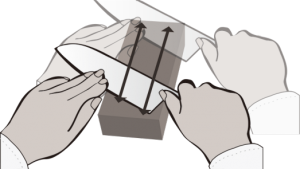
Now move the blade – with a little pressure – in regular movements up and down along the sharpening stone. Always maintain the angle between the blade and stone. You will notice a burr become visible after five or so movements. Mentally divide the blade into three sections if the knife has a large blade. Always start with the tip and work back towards the bolster.
Changing Sides
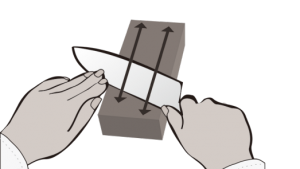
Now turn the knife over so that the blade is no longer pointing towards you. Continue to maintain the angle of 10 – 20° and the gap of approx. 5 mm from the back of the blade to the sharpening stone. Slide the cutting edge up and down over the sharpening stone. Grind both sides of the blade alternately, around five to ten times on each side.
Removing the Burr
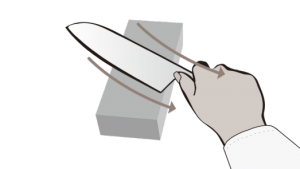
To remove the resulting burr from the knife, draw the knife in a curve from top left to bottom right across the sharpening stone. Then hold your knife under running water to remove all residue and then dry it carefully.
Testing the Sharpness

You can use a sheet of paper to check the sharpness of your knife. Your knife is perfectly sharp if it glides through the sheet of paper under light pressure and without slipping. If you are not yet satisfied with the sharpness of your knife, repeat steps 1-5 until you have achieved the desired sharpness.
Cutting Edge Tips:
- If the knives are not used for an extended period of time, wrap them in a dry cloth or newspaper and store them in a dry place; the hygroscopic paper will keep the blades dry and the oil from the printing ink prevents corrosion
- Select the correct knife for the task to ensure you will get the best cutting results and you are also easy on the blades. Never use knives to cut hard food, like shellfish or frozen food. When cutting, avoid bending the knives, as this could damage the sensitive cutting edges
Are Miyabi Knives Worth It?
Cooking & Food prep are like any fine art. Just like a ballerina needs their ballet shoes and an artist needs their paintbrush, any fine chef needs quality kitchen tools at their disposal. Quality knives are what Miyabi stand for. Exceptional & beautiful sharpness, tradition, craftsmanship, high-class performance, elegant design & reliability are all qualities that come along with owning a Miyabi knife. There aren’t other brands that can top Miyabi. The Miyabi knives that come out of the Zwilling J.A.Henckels factory in Seki, Japan belong up on a pedestal with only a small selection of other brands. If you’re after an Asian-style kitchen knife, Miyabi will always be one of our top suggestions.